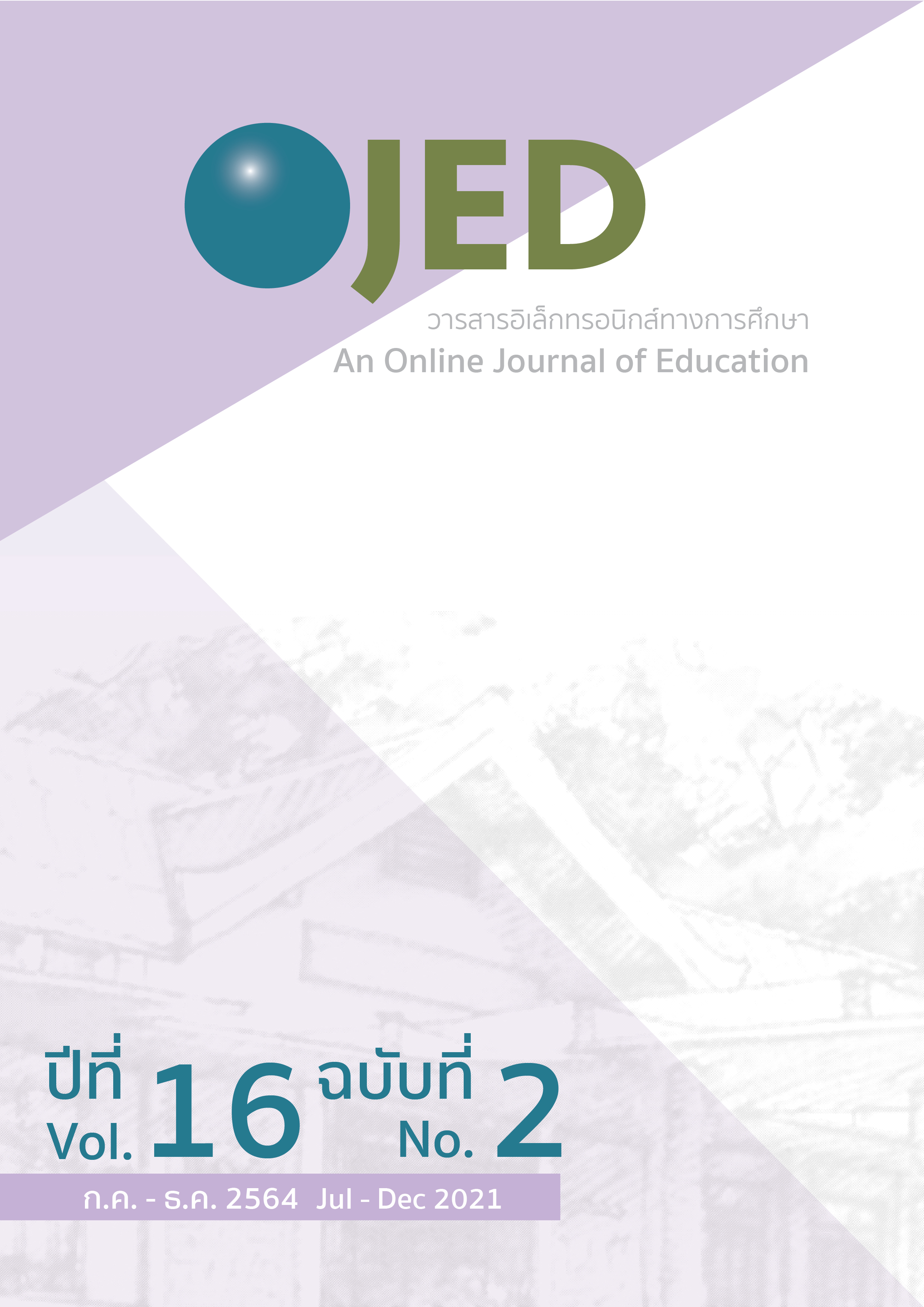Analysis of Factors and Indicators of Teacher Roles for Student Learning in the 21st Century
DOI:
https://doi.org/10.14456/ojed.2021.59Keywords:
indicators, teacher roles, student learning in the 21st centuryAbstract
The purpose of this study was to analyze the factors and indicators of teacher roles for student learning in the 21st century. This study was the qualitative study by synthesis the documents and previous researches and collecting data from 10 educational experts via interviews. The data were analyzed by content analysis. Research result was teacher roles for student learning in the 21st century consisted of 3 factors covering 10 indicators. Factor 1 Facilitator measured by 3 indicators consisted of the learning design, the atmosphere management, and the learning integration. Next, Factor 2 Coach measured by 4 indicators consisted of coaching the student self-learning, stimulating with the questions, teaching ability, and observing the students’ behavior. Finally, Factor 3 Co-learner/Co-investigator covering 3 indicators consisted of being open minded, collaborating and exchanging the knowledge, and acquiring knowledge.
References
พิมพันธ์ เดชะคุปต์. (2558). การจัดการเรียนรู้ในศตวรรษที่ 21 (พิมพ์ครั้งที่ 2). จุฬาลงกรณ์มหาวิทยาลัย
ภาสกร เรืองรอง, ประหยัด จิระวรพงศ์, วณิชชา แม่นยำ, วิลาวัลย์ สมยาโรน, ศรัณยู หมื่นเดช, และ ชไมพร ศรีสุราช. (2556). เทคโนโลยีการศึกษากับครูไทยในศตวรรษที่ 21. https://hooahz.wordpress.co
m/tag/%E0%B8%84%E0%B8%A3%E0%B8%B9%E0%B9%84%E0%B8%97%E0%B8%A2%E0%B9%83%E0%B8%99%E0%B8%AD%E0%B8%99%E0%B8%B2%E0%B8%84%E0%B8%95/
วิจารณ์ พานิช. (2556). การสร้างการเรียนรู้สู่ศตวรรษที่ 21. มูลนิธิสยามกัมมาจล
สุจริต เพียรชอบ. (2537). การมัธยมศึกษาในอนาคต. มหาวิทยาลัยสุโขทัยธรรมาธิราช.
สำนักงานเลขาธิการสภาผู้แทนราษฎร. (2559). ปัญหาครู: ปัญหาที่รอการปฏิรูป. https://library2.parliament.go.th/ebook/content-issue/2559/hi2559-091.pdf
อ่องจิต เมธยะประภาส. (2557). คุณลักษณะของครูและนักเรียนในศตวรรษที่ 21. http://www.plan.obec.go.th/download/tukmong/presen1.ppt
Ansari, U., & Malik, S. K. (2013). Image of an effective teacher in 21st century classroom. Journal of educational and instructional studies in the world, 3(4), 61-68.
Commitment to the role of the teacher as a facilitator of learning. (2007). Characteristics of a 21st century classroom. http://woulibrary.wou.edu.my/weko/eed502/Characteristics_of_a_21st_Century_Classroom.pdf
Douglas, B. H. (2007). Teaching by principles. An interactive approach to language (3rd ed.). https://dokumen.tips/documents/teaching-by-principles-h-douglas-brown-third-edition-2.html
Faulkner, S. L. (2016). Poetry as method: Reporting research through verse. Routledge.
Fernado, M. R., & Connie, K. C. (2016). Teaching and learning for the twenty-first century: Educational goals, policies, and curricula from six nations. Harvard Education Press
Harden, R. M., & Crosby, J. (2000). AMEE Guide No 20: The good teacher is more than a lecturer - the twelve roles of the teacher. Medical Teacher, 22(4), 334-347. https://doi.org/10.1080/014215900409429
Harmer, J. (2007). The practice of English language teaching. http://www.beagroves.net/bgtd/handouts/index.php?dir=Books%2FEnglish+%26+TEFL%2FTEFL%2F&download=Jeremy_Harmer_The_Practice_of_English_Language_Teaching_4th_Edition_Longman_Handbooks_for_Language_Teachers.pdf
Harrison, C., & Killion, J. (2007). Ten roles for teacher leaders. Teachers as Leaders, 65(1), 74-77. http://www.debbiewaggoner.com/uploads/1/2/9/9/12998469/ten_roles_for_teacher_leaders.pdf
Nola, A. (2016). The 7 roles of a teacher in the 21st century. Eton Institute. https://etoninstitute.com/blog/the-7-roles-of-a-teacher-in-the-21st-century
Robinson, K., & Aronica, L. (2009). The Element: How Finding Your Passion Changes Everything. Viking.
Trilling, B., & Fadel, C. (2009). 21st century skills: Learning for life in our times. Jossey-Bass
Zeiger, S. (2000). Teaching Peace: Lessons from a Peace Studies Curriculum of the Progressive Era. Peace & Change, 25(1), 53-70. https://doi.org/10.1111/0149-0508.00141
Downloads
Published
How to Cite
Issue
Section
License

This work is licensed under a Creative Commons Attribution-NonCommercial-NoDerivatives 4.0 International License.




